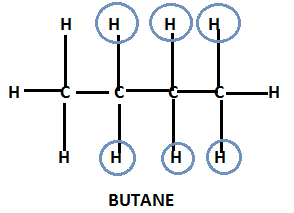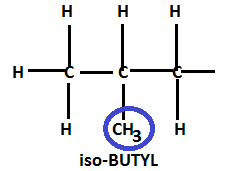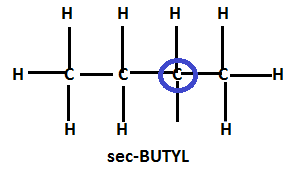
What is the difference between isobutyl and sec-butyl?
Answer
412.8k+ views
Hint: There are a number of organic groups which act as substituent in writing IUPAC name of the compound.The purpose of the IUPAC system of nomenclature is to establish an international standard of naming compounds to facilitate communication. The goal of the system is to give each structure a unique and unambiguous name, and to correlate each name with a unique and unambiguous structure.
Complete answer:
Isobutyl and sec-butyl are alkyl radicals which are produced from their parent compound butane.
Butane is represented by the general formula RH where R is called an alkyl group or radical and they are represented as
The alkyl group contains only one hydrogen atom less than the alkane. Hence, alkyl radical of butane has molecular formula
As we know the basic structure of butane is –

In the molecular structure of butane, we see that there are four secondary hydrogen atoms which are equivalent in nature. Replacing any one of these equivalent hydrogen by the methyl group from the parent structure of butane will lead to formation of a structure which is commonly known as isobutyl.

Hence, the total number of carbons in isobutyl remains the same, only the position of the methyl group is changed.
Similarly, removal of one of the secondary hydrogens from the parent structure will lead to the formation of a structure commonly known as sec-butyl.

Hence, the total number of carbons in sec-butyl remains the same, the position of all the carbon remains the same, only the number of hydrogens is reduced by one.
Hence, the basic difference between isobutyl and sec-butyl is the arrangement of carbon atoms to the parent molecule.
Note:
Both compounds namely isobutyl and sec-butyl can react with the same reagent to form different products. For example, on reacting with aqueous sodium hydroxide isobutyl form
Complete answer:
Isobutyl and sec-butyl are alkyl radicals which are produced from their parent compound butane.
Butane is represented by the general formula RH where R is called an alkyl group or radical and they are represented as
The alkyl group contains only one hydrogen atom less than the alkane. Hence, alkyl radical of butane has molecular formula
As we know the basic structure of butane is –

In the molecular structure of butane, we see that there are four secondary hydrogen atoms which are equivalent in nature. Replacing any one of these equivalent hydrogen by the methyl group from the parent structure of butane will lead to formation of a structure which is commonly known as isobutyl.

Hence, the total number of carbons in isobutyl remains the same, only the position of the methyl group is changed.
Similarly, removal of one of the secondary hydrogens from the parent structure will lead to the formation of a structure commonly known as sec-butyl.

Hence, the total number of carbons in sec-butyl remains the same, the position of all the carbon remains the same, only the number of hydrogens is reduced by one.
Hence, the basic difference between isobutyl and sec-butyl is the arrangement of carbon atoms to the parent molecule.
Note:
Both compounds namely isobutyl and sec-butyl can react with the same reagent to form different products. For example, on reacting with aqueous sodium hydroxide isobutyl form
Recently Updated Pages
Master Class 10 Science: Engaging Questions & Answers for Success

Master Class 10 Social Science: Engaging Questions & Answers for Success

Master Class 10 Maths: Engaging Questions & Answers for Success

Master Class 10 English: Engaging Questions & Answers for Success

Class 10 Question and Answer - Your Ultimate Solutions Guide

Master Class 9 General Knowledge: Engaging Questions & Answers for Success

Trending doubts
State and prove Bernoullis theorem class 11 physics CBSE

1 ton equals to A 100 kg B 1000 kg C 10 kg D 10000 class 11 physics CBSE

State the laws of reflection of light

One Metric ton is equal to kg A 10000 B 1000 C 100 class 11 physics CBSE

Difference Between Prokaryotic Cells and Eukaryotic Cells

1 Quintal is equal to a 110 kg b 10 kg c 100kg d 1000 class 11 physics CBSE




